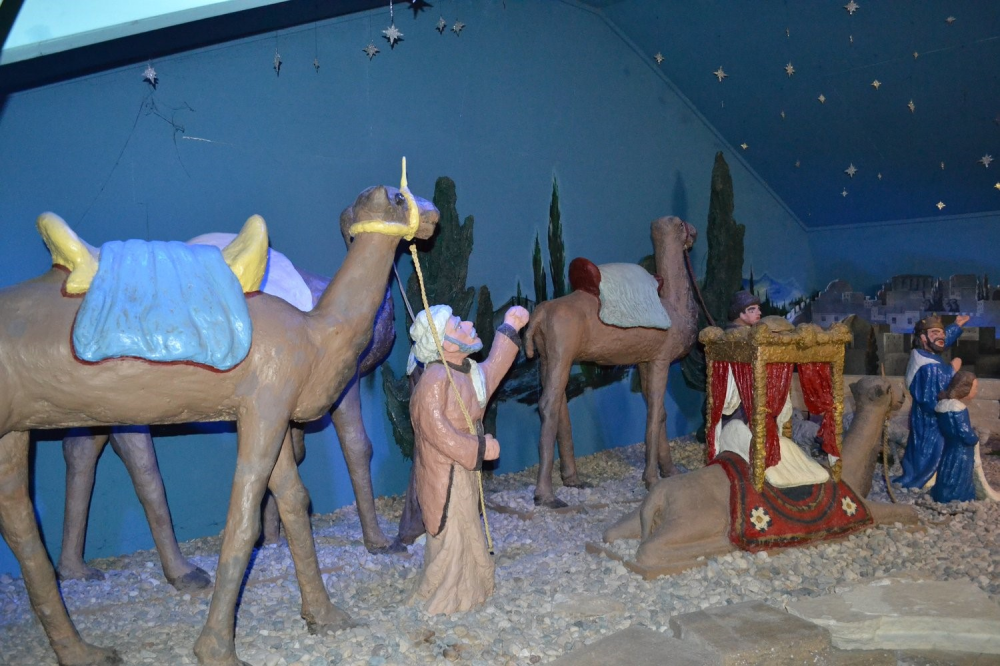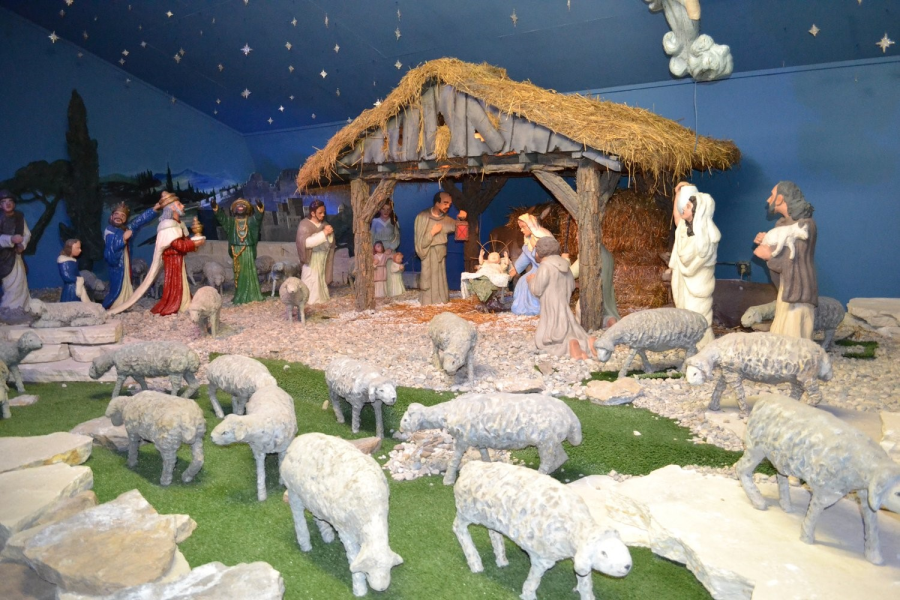A Christmas Gift in Algona
December 12, 2021
By Kriss Nelson, Iowa Soybean Association
It has been 76 years since prisoners of war near Algona unveiled their own Christmas miracle – a nativity scene featuring 65 half-life-sized figures.
 Please note, by clicking the below links, you’ll be leaving a partially funded checkoff site.
Please note, by clicking the below links, you’ll be leaving a partially funded checkoff site.
Nativity scenes depicting the birth of Jesus Christ are a reminder of the true reason for the season, and there is nothing that compares to the Algona Nativity Scene.
This one-of-a-kind re-creation of that blessed day 2,021 years ago was created by German prisoners of war during World War II who were being held at the Prisoner of War (POW) Camp near Algona.
“We feel very blessed this happened in our community,” says Algona Nativity Scene volunteer Marv Chickering. “It was a huge God wink.”
A Present to the Prisoners
Eduard Kaib was one of the hundreds of thousands of German soldiers wounded in World War II. After his capture, he was brought to Algona, where he later became the heart and soul behind building the beloved Algona Nativity Scene.
Being a non-commissioned officer, Kaib wasn’t forced to work outside of the camp, so as Christmas approached, he had recouped from a gastric ulcer and began working on a nativity scene.
“Christmas was coming, and he wanted the prisoners to be able to celebrate,” says Chickering.
The first nativity was 12-feet wide. Kaib made the figures out of dirt, hardened them on a stove and painted them, along with a Christmas tree and put them on display in the camp’s mess hall.
The camp commander, Lt. Col. Arthur Lobdell, saw the nativity and was impressed.
“Wanting to give the prisoners a more meaningful Christmas, Lobdell called Eduard to his office and asked if he would consider building a larger one for the 1945 Christmas,” says Chickering.
Kaib and five of his friends began working on 65 half-life-sized figures to help tell the nativity story.
The figures are constructed out of wood with layers of concrete. In addition to Jesus, Mary and Joseph, the figures feature shepherds, wise men, children, animals, a manager and more.
“There are 36 sheep in the nativity, and no two are alike. There were no molds. They did it with their bare hands,” says Chickering. “It was unveiled for the first time Christmas Eve in 1945 at the camp.”
He adds, “Important people from the community were invited to see the display. The German prisoners were there. The American military was there, and the Christmas carols were sung in German and English together. There was not a dry eye in the house.”
A Revelation
For 61 years, they only knew of Kaib and no other names of the prisoners that helped build the nativity.
In 2006, Ingrid Hazelton, from Texas, alerted the committee that her father, Horst Wendlandt, was one of the men who helped to construct the nativity.
Wendlandt couldn’t make the trip; however, he sent his story of the time he spent working on the nativity and as a POW at Camp Algona.
He tells of working on Frank Miller’s dairy farm near Laurens.
“Miller also stated that if things worked out well, he would treat Horst as he would his own son and will the farm to him upon his death,” says Chickering.Wendlandt recalled the day Miller told him his only son had been killed fighting the Japanese and that he wanted Wendlandt to return to the dairy farm to work after the war.
After his return to Germany, Wendlandt moved back to the U.S., settling in Texas to be with family.
Chickering considers it a huge “God wink” that Kaib, Wendlandt and the three other POWs accomplished building the nativity in less than a year.

“They would work on the farm all day and were able to work with the others to build it,” says Chickering. “They cared enough to give this gift to their fellow soldiers.”
The POWs filled a labor shortage for farmers in the area.
“The labor needs were huge. Our men were fighting a war,” he says.
Chickering shared some letters compiled in “A Collection of Memories of the Algona Prisoner of War Camp 1943-1946,” which detail accounts of POWs and their relationships with farmers in the Algona area.
Jean Shey from Algona was 12 years old when her father hired five prisoners to help on the family’s farm near West Bend. Being able to speak German, her father grew close to the prisoners – specifically POW Wilhelm Schittges.
Before Schittges returned to Germany, Shey says her father told him, “When you arrive in Germany, and you have hunger, write me.” When Schittges returned home, he found his wife nearly starved to death and his apartment in ruins. At first, he was too ashamed to write for help. But three months passed, and the conditions worsened.
Over time Shey’s father sent 10 packages of food, clothes, butter, meat and chocolate.
“When the first box of food arrived, they walked to an entrance of a store, tore it open and on top was a chocolate bar. His wife, who was pregnant, devoured it immediately,” says Chickering. “Schittges told Shey, ‘Without your packages, we would have starved to death.’”
Joanne (Meyer) Hackbarth read letters her father, Martin Meyer, received from POW Johann Seip.
Seip, who worked on several farms in Iowa and factories in southern Minnesota, wrote, “It was very good by the farmers but never so good as we had it in Algona.” After seeing the devastation in his home country, he wrote, “I would rather go to America again to you on the farm, then I would have everything I need.”
“Silent Night in Algona”
Although it has been 76 years since the reveal of the nativity scene, the night’s importance is not forgotten. In fact, filming of the movie, “Silent Night in Algona” is underway and expected to be released next fall.
The film is produced by Collective Development Inc. of Lansing, Michigan under the direction of Anthony Hornus and written by DJ Perry. The movie stars Terence Knox, Taylor Nichols and Melissa Anschutz.
Chickering is excited for the movie to help spread the word of the POW camp and the prisoners who provided Algona with such a precious gift.
“It’s wonderful the people I meet that come to visit, but so many of them are totally clueless these events happened,” he says.
For Chickering, one precious sheep story stands out from his years of volunteering at the Algona Nativity Scene.
 He says it was a New Year’s Eve – the last day of the year for the nativity to be open.
He says it was a New Year’s Eve – the last day of the year for the nativity to be open.
“I was lonely out here. I had no guests. Until a great-grandpa, who was a World War II vet from our community, walked in with two great-granddaughters. He was telling me war stories, so I told the girls to go in and count the sheep – but to not fall asleep. They came back, and I asked the older girl how many sheep are there? She said there are 32 sheep. Well, at that time, there were 31. I asked her how did you get 32? She said, well there are 30 adult sheep. There is the lamb in the shepherd’s arm and there is the Christ Child, the Lamb of God. My only remark was, Amen,” he says.
The Algona Nativity Scene is cared for by the Men’s Club of Algona First United Methodist Church. Beginning Dec. 1, it is open from noon to 8 p.m. Sundays and Christmas Day; Monday through Saturday, 2 p.m. to 8 p.m. and closes for the season at 6 p.m., Dec. 31. Special appointments can be made by contacting the church office at 515-295-241 or visiting http://algonanativityscene.omeka.net.
Please note, by clicking the above links, you’ll be leaving a partially funded checkoff site.